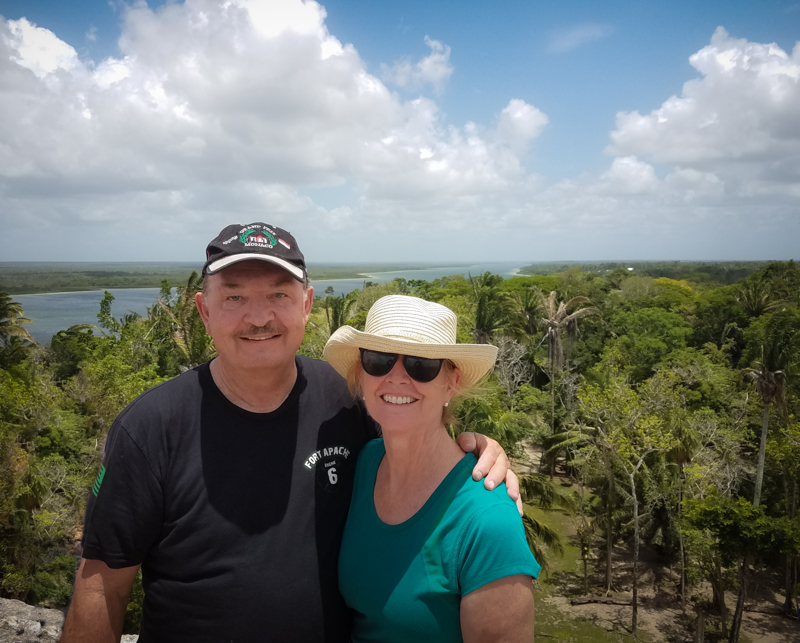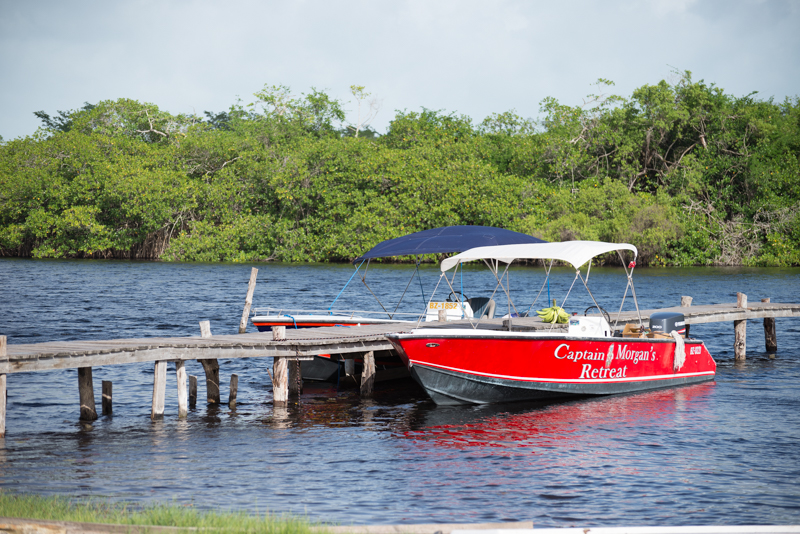Jungle cruisin’ through the waters of Belize . . . binoculars in one hand, tropical drink in the other . . . slow and easy . . . restful and relaxing . . . NOT!
At first, it was a mental challenge to resist what seemed like a natural propensity to be seasick as we crossed over the 20-or-so miles of choppy Caribbean waters to the mainland.
But then, after we arrived at our destination, the Lamanai Mayan site, the challenge was more physical. It was more like an endurance test to decide which was the best look-out spot after climbing several ancient temples.
My Fitbit went nuts! It was the first time I doubted its accuracy when it showed I had climbed 122 flights of stairs and walked more than 23,000 steps in one day!
But, I’m getting ahead of myself. Let me start with our native-Belizean tour guide and captain extraordinaire . . . .
Our Captain Morgan’s Resort Tour Guide, Herman
Herman, our Captain Morgan’s boat captain and chief tour guide, was excellent. A native Belizean, he knows the area like the back of his hand — and he made it all so interesting.
He could tell us just about everything there is to know about the Belizean Barrier Reef and the mainland. Like what types of underwater vegetation color the San Pedro Bay a combination of bright azul, a soft turquoise, a cocoa brown, or a variegated bottle green.
He also knows wildlife and their habitat, like where we could find lively spider monkeys and tiny sleeping bats.
He pointed out rare Black Orchids, Mayan palms, and species of indigenous birds too numerous to mention. And, when weather conditions changed from sunshine to a brief rainstorm, Herman knew where to seat people in our speed boat according to the height of the waves. (Yikes!) Yes, Herman was our tour guide, but he was also the planner, coordinator, and marketer. Even before our journey was over, our group was more than happy to have him in charge of the boat. The open and untamed waters just off the Belize Barrier Reef can make for one heck of a rough ride!
The Journey
After introducing himself, Herman explained to our small group of 13 people that our all-day tour would be a three-part journey to the Mayan ruins site.
For the first leg, we would cruise the rough seas of the Caribbean from the island of Ambergris Caye over to the mainland and on up the river to the small inland village of Bomba.
For the second leg of the journey, we would board a bus and drive the rough, inner-country roads to the North River.
Then, when we reached the North River, we would board another boat that would take us approximately 27 miles through the jungle to the Lamanai Mayan ruins.
Sounds simple enough, right?
It was simple – but quite an adventure! The round-trip from Ambergris to the Lamanai Mayan ruins and then back to Ambergis took about ten and one-half hours and it was worth every minute!
The Lamanai Mayan Ruins
The Lamanai is an impressive Mayan site where hundreds, if not thousands, of people once called home. No one knows exactly what happened to this civilization, but the temples, statues, and even a ball court are curiously well-preserved.
Although many other artifacts and buildings have been excavated, the guide informed us that further excavations are not planned because the site brings in enough paying visitors to keep the museum staffed and open. In the future, if the site does not continue to produce adequate revenue, then the government will consider opening up another archaeological dig.
Although it has steps across the front, they are steep and uneven, and each step is about equal to three stairs. In other words, they’re almost impossible to climb. Because of this, the park service has built a wooden staircase in the back where people can climb about two-thirds of the temple. The wood staircase is still very steep and a difficult climb, but at least there’s a handrail so there’s a little less risk. The view from the top, by the way, is incredible!
Belizeans Working Together
Perhaps one of the most enlightening facts we learned about the whole experience was how Belizeans work together to make things happen.
For example, they respect one another on the rivers and give priority to boats with passengers — and especially boats with tourists. If only locals are cruising the river, then whoever enters the water first has priority to decide the direction of travel for a certain period of time for that day. Locals communicate almost constantly about river travel through word of mouth or by cell phone so there’s less chance for boating collisions.
They also rely on one another for land or water conditions. Like when we had to take a detour because of a fast-moving storm further up the river, Herman and other locals communicated to ensure our boat wouldn’t get stuck in one of the underwater webs of mangrove roots.

The roots of the Mangroves must be trimmed on a regular basis to keep the river clear and safe for navigation.
Our tour included lunch and Herman’s family prepared a feast for us. We had a delicious, hot, home-cooked meal of stewed chicken, black beans and rice, fried plantains, homemade tortillas, and habanero and onion salsa.
There were also big coolers full of ice cold water, fruity rum punch, and Belikin (the local brand) beer. I can only imagine what an undertaking it must have been for family members to bring all of that prepared food, heavy coolers full of drinks, plus plates and flatware to the middle of the jungle at the foot of the Lamanai site. It was yet another example of how a tight-knit family of Belizeans coordinated their skills and pooled their resources to share their way of life with others.
From traversing the untamed waters of the Caribbean Sea to riding the rough, unmarked, and occasionally paved roads of the inner country, it took a “village of people” to make an excursion to the Lamanai Mayan ruins happen.
Follow us on social media!











Can’t wait to hear and see more about this trip.